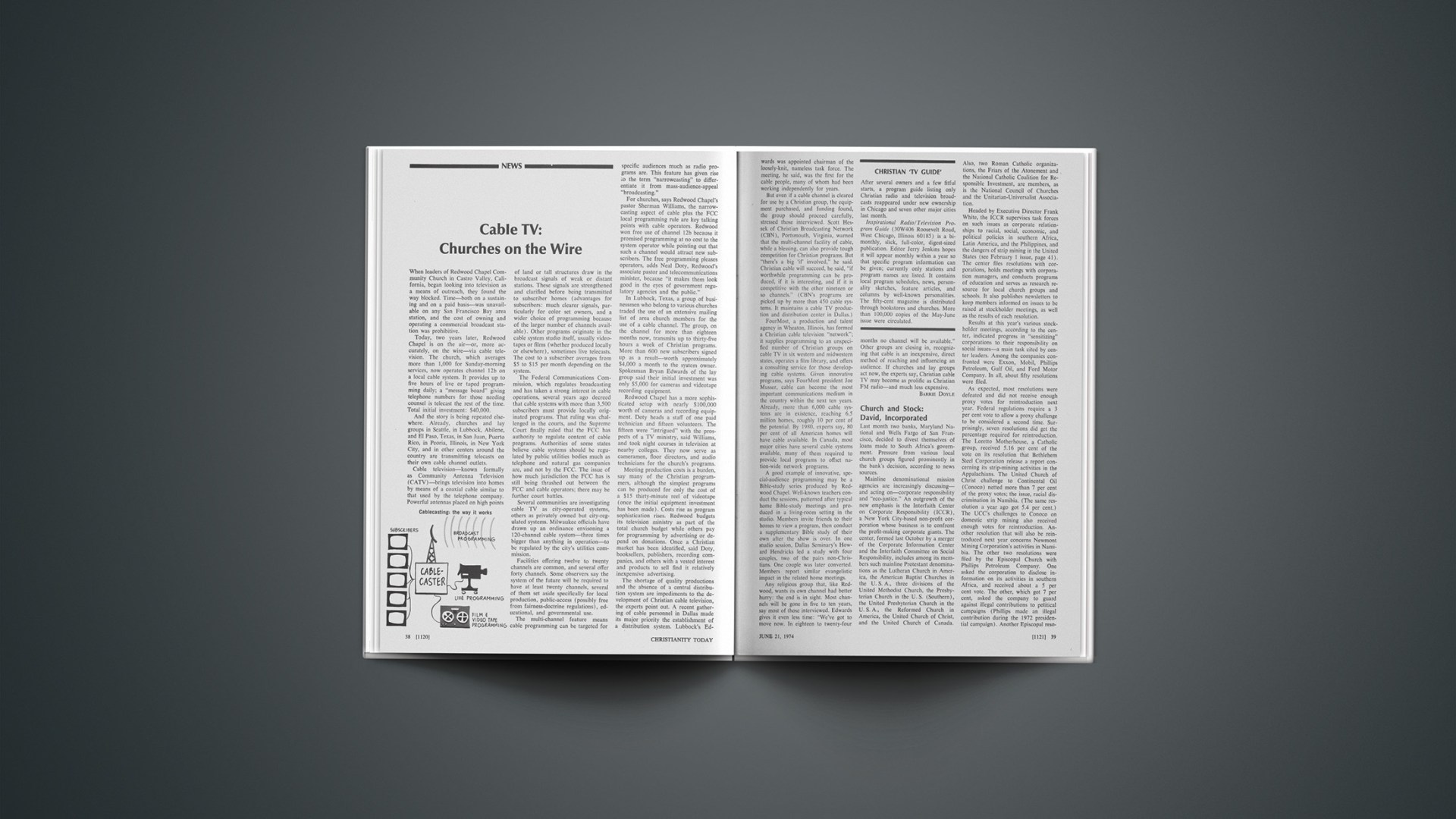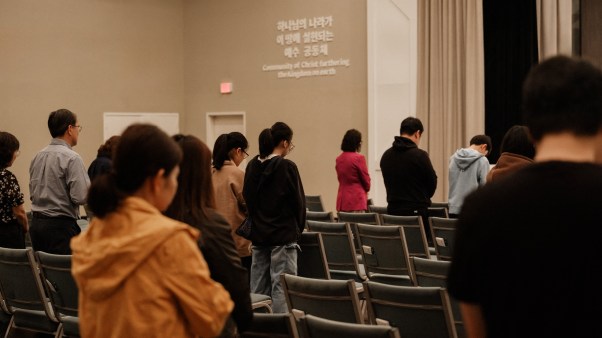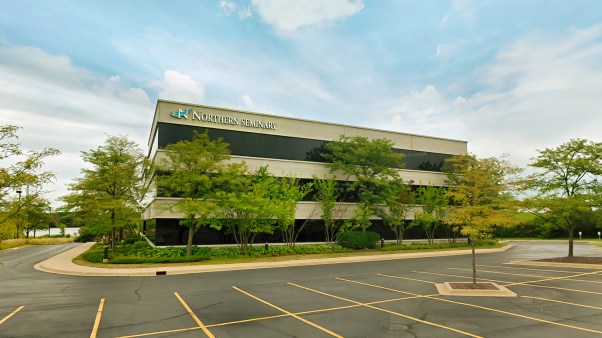When leaders of Redwood Chapel Community Church in Castro Valley, California, began looking into television as a means of outreach, they found the way blocked. Time—both on a sustaining and on a paid basis—was unavailable on any San Francisco Bay area station, and the cost of owning and operating a commercial broadcast station was prohibitive.
Today, two years later, Redwood Chapel is on the air—or, more accurately, on the wire—via cable television. The church, which averages more than 1,000 for Sunday-morning services, now operates channel 12b on a local cable system. It provides up to five hours of live or taped programming daily; a “message board” giving telephone numbers for those needing counsel is telecast the rest of the time. Total initial investment: $40,000.
And the story is being repeated elsewhere. Already, churches and lay groups in Seattle, in Lubbock, Abilene, and El Paso, Texas, in San Juan, Puerto Rico, in Peoria, Illinois, in New York City, and in other centers around the country are transmitting telecasts on their own cable channel outlets.
Cable television—known formally as Community Antenna Television (CATV)—brings television into homes by means of a coaxial cable similar to that used by the telephone company. Powerful antennas placed on high points of land or tall structures draw in the broadcast signals of weak or distant stations. These signals are strengthened and clarified before being transmitted to subscriber homes (advantages for subscribers: much clearer signals, particularly for color set owners, and a wider choice of programming because of the larger number of channels available). Other programs originate in the cable system studio itself, usually videotapes or films (whether produced locally or elsewhere), sometimes live telecasts. The cost to a subscriber averages from $5 to $15 per month depending on the system.
The Federal Communications Commission, which regulates broadcasting and has taken a strong interest in cable operations, several years ago decreed that cable systems with more than 3,500 subscribers must provide locally originated programs. That ruling was challenged in the courts, and the Supreme Court finally ruled that the FCC has authority to regulate content of cable programs. Authorities of some states believe cable systems should be regulated by public utilities bodies much as telephone and natural gas companies are, and not by the FCC. The issue of how much jurisdiction the FCC has is still being thrashed out between the FCC and cable operators; there may be further court battles.
Several communities are investigating cable TV as city-operated systems, others as privately owned but city-regulated systems. Milwaukee officials have drawn up an ordinance envisoning a 120-channel cable system—three times bigger than anything in operation—to be regulated by the city’s utilities commission.
Facilities offering twelve to twenty channels are common, and several offer forty channels. Some observers say the system of the future will be required to have at least twenty channels, several of them set aside specifically for local production, public-access (possibly free from fairness-doctrine regulations), educational, and governmental use.
The multi-channel feature means cable programming can be targeted for specific audiences much as radio programs are. This feature has given rise to the term “narrowcasting” to differentiate it from mass-audience-appeal “broadcasting.”
For churches, says Redwood Chapel’s pastor Sherman Williams, the narrowcasting aspect of cable plus the FCC local programming rule are key talking points with cable operators. Redwood won free use of channel 12b because it promised programming at no cost to the system operator while pointing out that such a channel would attract new subscribers. The free programming pleases operators, adds Neal Doty, Redwood’s associate pastor and telecommunications minister, because “it makes them look good in the eyes of government regulatory agencies and the public.”
In Lubbock, Texas, a group of businessmen who belong to various churches traded the use of an extensive mailing list of area church members for the use of a cable channel. The group, on the channel for more than eighteen months now, transmits up to thirty-five hours a week of Christian programs. More than 600 new subscribers signed up as a result—worth approximately $4,000 a month to the system owner. Spokesman Bryan Edwards of the lay group said their initial investment was only $5,000 for cameras and videotape recording equipment.
Redwood Chapel has a more sophisticated setup with nearly $100,000 worth of cameras and recording equipment. Doty heads a staff of one paid technician and fifteen volunteers. The fifteen were “intrigued” with the prospects of a TV ministry, said Williams, and took night courses in television at nearby colleges. They now serve as cameramen, floor directors, and audio technicians for the church’s programs.
Meeting production costs is a burden, say many of the Christian programmers, although the simplest programs can be produced for only the cost of a $15 thirty-minute reel of videotape (once the initial equipment investment has been made). Costs rise as program sophistication rises. Redwood budgets its television ministry as part of the total church budget while others pay for programming by advertising or depend on donations. Once a Christian market has been identified, said Doty, booksellers, publishers, recording companies, and others with a vested interest and products to sell find it relatively inexpensive advertising.
The shortage of quality productions and the absence of a central distribution system are impediments to the development of Christian cable television, the experts point out. A recent gathering of cable personnel in Dallas made its major priority the establishment of a distribution system. Lubbock’s Edwards was appointed chairman of the loosely-knit, nameless task force. The meeting, he said, was the first for the cable people, many of whom had been working independently for years.
But even if a cable channel is cleared for use by a Christian group, the equipment purchased, and funding found, the group should proceed carefully, stressed those interviewed. Scott Hessek of Christian Broadcasting Network (CBN), Portsmouth, Virginia, warned that the multi-channel facility of cable, while a blessing, can also provide tough competition for Christian programs. But “there’s a big ‘if’ involved,” he said. Christian cable will succeed, he said, “if worthwhile programming can be produced, if it is interesting, and if it is competitive with the other nineteen or so channels.” (CBN’s programs are picked up by more than 450 cable systems. It maintains a cable TV production and distribution center in Dallas.)
FourMost, a production and talent agency in Wheaton, Illinois, has formed a Christian cable television “network”; it supplies programming to an unspecified number of Christian groups on cable TV in six western and midwestern states, operates a film library, and offers a consulting service for those developing cable systems. Given innovative programs, says FourMost president Joe Musser, cable can become the most important communications medium in the country within the next ten years. Already, more than 6,000 cable systems are in existence, reaching 6.5 million homes, roughly 10 per cent of the potential. By 1980, experts say, 80 per cent of all American homes will have cable available. In Canada, most major cities have several cable systems available, many of them required to provide local programs to offset nation-wide network programs.
A good example of innovative, special-audience programming may be a Bible-study series produced by Redwood Chapel. Well-known teachers conduct the sessions, patterned after typical home Bible-study meetings and produced in a living-room setting in the studio. Members invite friends to their homes to view a program, then conduct a supplementary Bible study of their own after the show is over. In one studio session, Dallas Seminary’s Howard Hendricks led a study with four couples, two of the pairs non-Christians. One couple was later converted. Members report similar evangelistic impact in the related home meetings.
Any religious group that, like Redwood, wants its own channel had better hurry: the end is in sight. Most channels will be gone in five to ten years, say most of those interviewed. Edwards gives it even less time: “We’ve got to move now. In eighteen to twenty-four months no channel will be available.” Other groups are closing in, recognizing that cable is an inexpensive, direct method of reaching and influencing an audience. If churches and lay groups act now, the experts say, Christian cable TV may become as prolific as Christian FM radio—and much less expensive.
CHRISTIAN ‘TV GUIDE’
After several owners and a few fitful starts, a program guide listing only Christian radio and television broadcasts reappeared under new ownership in Chicago and seven other major cities last month.
Inspirational Radio/Television Program Guide (30W406 Roosevelt Road, West Chicago, Illinois 60185) is a bimonthly, slick, full-color, digest-sized publication. Editor Jerry Jenkins hopes it will appear monthly within a year so that specific program information can be given; currently only stations and program names are listed. It contains local program schedules, news, personality sketches, feature articles, and columns by well-known personalities. The fifty-cent magazine is distributed through bookstores and churches. More than 100,000 copies of the May–June issue were circulated.
Church And Stock: David, Incorporated
Last month two banks, Maryland National and Wells Fargo of San Francisco, decided to divest themselves of loans made to South Africa’s government. Pressure from various local church groups figured prominently in the bank’s decision, according to news sources.
Mainline denominational mission agencies are increasingly discussing—and acting on—corporate responsibility and “eco-justice.” An outgrowth of the new emphasis is the Interfaith Center on Corporate Responsibility (ICCR), a New York City-based non-profit corporation whose business is to confront the profit-making corporate giants. The center, formed last October by a merger of the Corporate Information Center and the Interfaith Committee on Social Responsibility, includes among its members such mainline Protestant denominations as the Lutheran Church in America, the American Baptist Churches in the U. S. A., three divisions of the United Methodist Church, the Presbyterian Church in the U. S. (Southern), the United Presbyterian Church in the U. S. A., the Reformed Church in America, the United Church of Christ, and the United Church of Canada. Also, two Roman Catholic organizations, the Friars of the Atonement and the National Catholic Coalition for Responsible Investment, are members, as is the National Council of Churches and the Unitarian-Universalist Association.
Headed by Executive Director Frank White, the ICCR supervises task forces on such issues as corporate relationships to racial, social, economic, and political policies in southern Africa, Latin America, and the Philippines, and the dangers of strip mining in the United States (see February 1 issue, page 41). The center files resolutions with corporations, holds meetings with corporation managers, and conducts programs of education and serves as research resource for local church groups and schools. It also publishes newsletters to keep members informed on issues to be raised at stockholder meetings, as well as the results of each resolution.
Results at this year’s various stockholder meetings, according to the center, indicated progress in “sensitizing” corporations to their responsibility on social issues—a main task cited by center leaders. Among the companies confronted were Exxon, Mobil, Phillips Petroleum, Gulf Oil, and Ford Motor Company. In all, about fifty resolutions were filed.
As expected, most resolutions were defeated and did not receive enough proxy votes for reintroduction next year. Federal regulations require a 3 per cent vote to allow a proxy challenge to be considered a second time. Surprisingly, seven resolutions did get the percentage required for reintroduction. The Loretto Motherhouse, a Catholic group, received 5.16 per cent of the vote on its resolution that Bethlehem Steel Corporation release a report concerning its strip-mining activities in the Appalachians. The United Church of Christ challenge to Continental Oil (Conoco) netted more than 7 per cent of the proxy votes; the issue, racial discrimination in Namibia. (The same resolution a year ago got 5.4 per cent.) The UCC’s challenges to Conoco on domestic strip mining also received enough votes for reintroduction. Another resolution that will also be reintroduced next year concerns Newmont Mining Corporation’s activities in Namibia. The other two resolutions were filed by the Episcopal Church with Phillips Petroleum Company. One asked the corporation to disclose information on its activities in southern Africa, and received about a 5 per cent vote. The other, which got 7 per cent, asked the company to guard against illegal contributions to political campaigns (Phillips made an illegal contribution during the 1972 presidential campaign). Another Episcopal resolution on illegal political contributions won backing by management of the Minnesota Mining and Manufacturing Company and got 97 per cent of the stockholder vote, the first time a church resolution has won.
ICCR director White says most corporations such as Polaroid or Exxon react “positively” to churches’ resolutions. If a company agrees to supply information as requested in the resolutions, churches withdraw them. This year sixteen companies agreed to supply information on employment of women and racial minorities, on measures used to combat the energy crisis, and on strip-mining activities, which are considered harmful to the environment. Exxon Corporation, for example, sent some top executives to the Interfaith Center to hold a five-hour discussion on the company’s proposed strip-mining activities. Exxon, explains White, “takes seriously our concern.”
Comments from companies range from complete approval of investments pressure as a legitimate mission for the church to requests that churches just “preach the Bible,” says White. Spokesmen for denominations involved in investments maintain that they do preach the Bible when discussing corporate responsibility with company management. As one analyst explained, this is a twentieth-century version of David and Goliath, but “the slingshots and pebbles have been replaced by stock portfolios, persuasion, and public opinion.”
CHERYL FORBES
God And Watergate
There’s been a lot of soul searching on the part of many slogging around in the morass of Watergate. In their search some have found God, and the outcome so far has been profound.
James McCord, the former CIA agent who headed up security for President Nixon’s reelection committee, says he wrote that tell-it-all letter last March to Judge John Sirica as a result of a series of sermons he heard preached by Pastor Richard Halverson in Washington’s Fourth Presbyterian Church.
This month attorney Charles Colson, the indicted former presidential counsel and Mr. Tough Guy of the Watergate cast, set off shock waves in Washington with a plea of guilty to a felony count of obstruction of justice. Sentencing was set for June 21.
As noted by the nation’s press, Colson’s decision and the wording of his statement were thrashed out in a small prayer group he joined soon after his conversion last August (see January 4 issue, page 48). The Sunday night before his plea he conferred and prayed with his spiritual mentors: Senator Harold Hughes of Iowa, Minnesota congressman Albert Quie, former Texas congressman Graham Purcell, and Douglas Coe, a lay missionary affiliated with Fellowship Foundation of Washington. (Quie, out of town on a speaking engagement, joined in by phone.)
“There were tears shed,” Hughes told reporters. “Here is a man who faces prison and disbarment.” Hughes said the group felt Colson might have gone free in a trial, “but he wanted to help in the cleansing process of the nation, to testify for the country and for Jesus Christ.”
Several weeks earlier Hughes and Colson had been quizzed about their faith in Christ by Mike Wallace on CBS-TV’s “Sixty Minutes,” the same day Hughes was interviewed on ABC-TV’s “Directions” about his faith and decision to engage in full-time lay ministry. Wallace had pushed Colson on the issue of righting the wrongs of the past. (Interestingly, Colson had already been quietly apologizing to certain persons for past misdeeds.)
A few months ago some of Colson’s Christian friends enlisted nearly 100 persons, many of them members of Fourth Presbyterian, to help him put together 5,000 Xerox pages of press clips in an attempt to convince the court he couldn’t get a fair trial anywhere in America.
Colson has said he will talk with government prosecutors; how much he tells and how far-reaching the consequences remain to be seen.
In an interview, Colson expressed dismay at the “lynch-mob atmosphere” and “lack of love” in Washington. At the same time he confessed that not too long ago he had a get-that-guy attitude himself. But Christ changed that, he said; now there’s love. He said he worries whether the nation “will ever find the healing that can only come when people turn to God and follow Christ.”
Religion has figured in the fortunes of other Watergate personalities, including former White House “plumber” Egil “Bud” Krogh and ex-presidential aide Jeb Magruder; both have expressed remorse over their past. Hughes says Krogh received Christ before he left for prison. Magruder, escorted to the courthouse by his pastor, Louis Evans, Jr., of National Presbyterian Church, told reporters he will spend part of his prison stay studying theology. Both men are serving light sentences at the federal minimum-security facility at Allenwood, Pennsylvania.
In the meantime, church leaders throughout the country were virtually unanimous in their condemnation of the moral attitudes they saw in the transcripts of White House meetings. Many critics harped on evangelist Billy Graham for not denouncing President Nixon. Graham said he deplored the moral tone of the papers but, as Nixon’s friend, had “no intention of forsaking him now.”
EDWARD E. PLOWMAN
Religion In Transit
Under pressure, Union Seminary president J. Brooke Mosley, 58, announced his resignation, effective no later than November, 1975. Mosley, former Episcopal bishop of Delaware, has served the New York school since 1970. He instituted a number of board-directed changes that resulted in unrest among faculty members and students.
Guerrillas in northeastern Ethiopia took over an American oil company helicopter, landed near the American Evangelical Church hospital in Ghinda, and kidnapped a pregnant missionary nurse, Mrs. Deborah Dortzbach, 24, of Freehold, New Jersey. A middle-aged Dutch nurse, Anna Strikwerda, was shot to death, apparently resisting capture. She was single. Orthodox Presbyterian mission officials who sponsor Mrs. Dortzbach theorize she was taken to provide medical assistance to the guerrillas.
Most of the 46,000 inhabitants of the island of Siau, Indonesia, have fled following destructive earthquakes and eruptions of a volcano. The majority of the people are affiliated with the Evangelical Christian Church in Sangihe Talaud, so named for two large islands nearby. Only a handful were killed, but some 1,500 houses, nine schools, eight churches, bridges, roads, and thousands of acres of farmland were wiped out.
Conservative faculty leader Robert D. Preus, 49, of Concordia Seminary, St. Louis, was elected president of Concordia Seminary, Springfield, Illinois. Meanwhile, Evangelical Lutherans in Mission (ELIM), the organization of liberal-moderate dissidents in the Lutheran Church-Missouri Synod, pledged $40,000 for support of Seminex graduates who fail to get official certification for pastoral placement. Seminex is the ELIM-backed school run by former teachers at Concordia, St. Louis.
DEATHS
GEORGE HENRY MORLING, 86, eminent Australian Baptist educator and evangelical leader; in New South Wales, Australia.
HAROLD C. SLADE, 71, controversial Toronto Baptist pastor and leader of several small separatist groups; in Toronto, of a heart attack.










